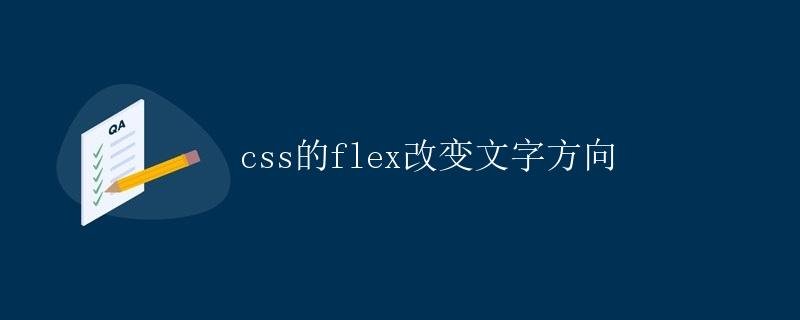CSS flex changes text direction
CSS flex changes text direction

In web development, we often encounter situations where we need to change text direction, such as making text display horizontally or vertically. In traditional front-end development, we use traditional methods to achieve text direction changes, such as using properties like float and text-align. Now, with the popularity of CSS3, we can use the more flexible and powerful flex property to achieve text direction changes.
What is Flex Layout?
Flex layout is a CSS3 layout mode that allows for simple, complete, and responsive layouts. Using flex layouts allows for simple and powerful layouts, making web development easier and more flexible.
display: flex
To use flex layout, first set the parent element’s display property to flex. This will cause the child elements to be laid out according to flex rules.
.container {
display: flex;
}
Main and Cross Axis
In flex layout, important concepts are the main axis and the cross axis. The main axis is the primary axis of the flex container, determining how flex items are arranged along the main axis, either horizontally or vertically. The cross axis is the axis perpendicular to the main axis.
.container {
display: flex;
flex-direction: row; /* Horizontal direction */
justify-content: flex-start; /* Alignment on the main axis */
align-items: flex-start; /* Alignment on the cross axis */
}
Using Flex to Change Text Direction
With the basics of flex layout, we can use the flex properties to change the direction of text. Specifically, we can use the flex-direction property to change the direction of text, allowing for vertical or horizontal text flow.
Horizontal Alignment
To align text horizontally, set the flex-direction property to row. By default, text flows horizontally. For example, the following example:
.horizontal {
display: flex;
flex-direction: row;
}
/* HTML */
<div class="horizontal">
<p>This is a horizontally aligned text. </p>
<p>This is another horizontally aligned text. </p>
</div>
In this example, the two texts will be displayed horizontally.
Vertical Alignment
To make the text align vertically, we can set the flex-direction property to column. This will cause the child elements to align vertically. For example, the following example:
.vertical {
display: flex;
flex-direction: column;
}
/* HTML part */
<div class="vertical">
<p>This is a vertically aligned text. </p>
<p>This is another vertically aligned text. </p>
</div>
In this example, the two texts will be displayed vertically.
Summary
Using the flex property, we can easily change the direction of text to achieve horizontal or vertical alignment. The flex layout provides a powerful and flexible layout method, making front-end development simpler and more efficient.